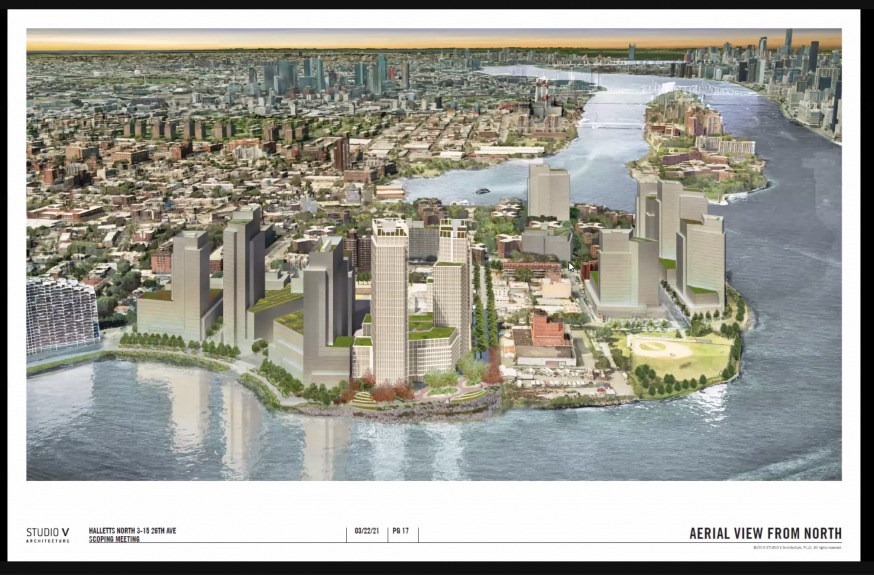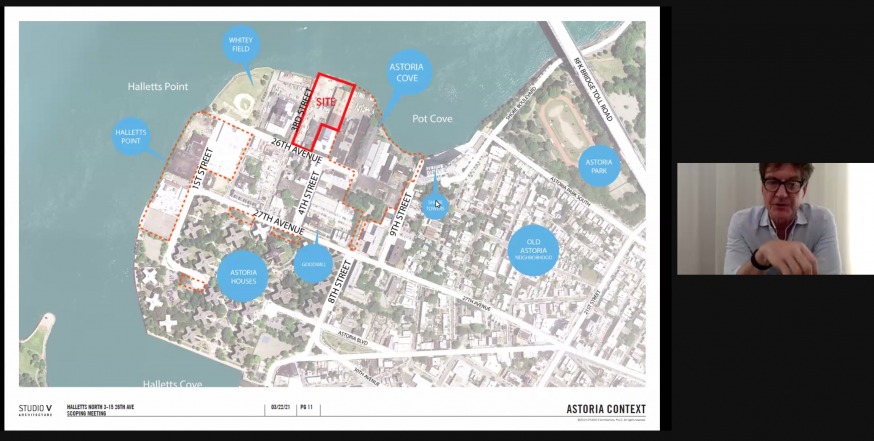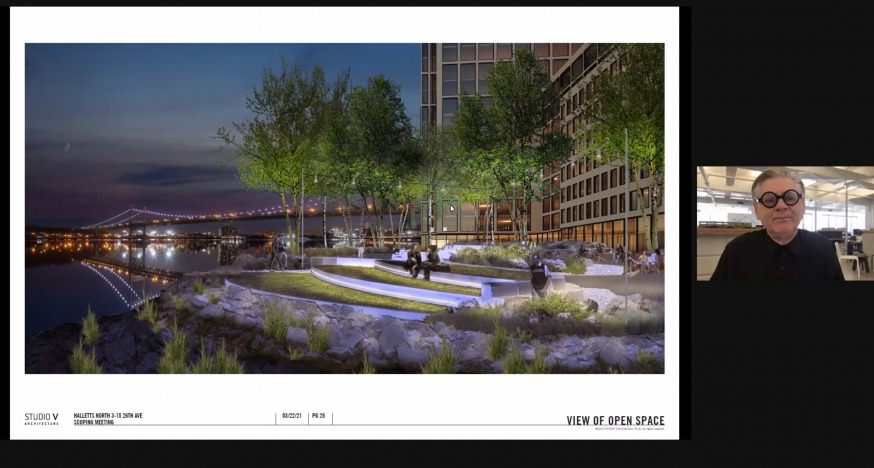 March 23, 2021 By Christina Santucci
March 23, 2021 By Christina Santucci
Representatives for the developers looking to build a 1,400-unit residential complex in Halletts Point previewed the plan for the public during a virtual scoping meeting Tuesday.
The developers are seeking to build a 1-million-square-foot project – called Halletts North – on a 3.8-acre industrial site, located on 26th Avenue between 3rd and 4th Streets. The proposal would require a number of zoning changes.
Jay Valgora for STUDIO V Architecture explained that Halletts North would be situated within the Halletts Point peninsula on the East River waterfront – near the seven-building Halletts Point and Astoria Cove projects.
He said the Halletts North “matches the surrounding community.”
“The kind of proposal we are making is extremely similar in density and type and use to all of the other approved residential developments on the waterfront,” Valgora said.
The Halletts North development would include a waterfront promenade, which Valgora said would help link nearly 2.5 miles of waterfront – stretching from Astoria Park to Rainey Park in Long Island City.
The waterfront area would include native plants and a rain garden—which would collect, filter and infiltrate stormwater runoff. The developers also plan to raise the site’s grade to protect it from storm surge and flooding, said Ken Smith of Ken Smith Workshop, a landscape architecture firm.

Presentation of plans by Jay Valgora for STUDIO V Architecture
The Halletts North proposal is expected to undergo the Uniform Land Use Review Procedure (ULURP), which is required for the zoning changes, later this year. If approved, construction could begin in the second half of 2022.
During the second part of the scoping meeting, Shawna Morlock, a local Democratic District Leader, and several community members commented on the project – some in favor and others against.
Morlock was wary that the project would lead to the gentrification of the area and worried about the environmental impact the development might have.
Evie Hantzopoulos, a member of Community Board 1 and candidate for Astoria’s City Council seat, said she had concerns including ones pertaining to traffic congestion and affordable housing.
She said the development would bring more cars to the peninsula “at a time when we need to get cars off the road.”
Hantzopoulos also called for affordable housing, and said that it had to be offered at income levels that are truly affordable.
“My biggest concern is the type of housing that is going up right now. This is primarily luxury housing at a time when we need affordable housing, and truly affordable housing,” Hantzopoulos said.
The developers will be required to set aside a percentage of units for affordable housing in accordance with the city’s Mandatory Inclusionary Housing (MIH) requirements.
In an environmental assessment statement filed last month, the developers proposed using either option 1 or 2 of the MIH guidelines.
Under option 1 of the guidelines, 25 percent of the total housing would be required to be set aside as affordable – on average – to households making 60 percent of the Area Median Income (AMI). For a family of four, that equates to approximately $68,000 per year.
For option 2, 30 percent – on average – must be affordable to households making 80 percent of the AMI, or $91,000 for a family of four.
In comparison, the median household income in the census tract containing Astoria Houses, which is about a block away from the project, is approximately $26,500, according to census estimates.
The developers have previously said that they plan to offer more than 300 affordable units, which would be geared toward those with incomes starting at $30,000.
Astoria Houses resident and Community Board 1 member Vanessa Jones-Hall also said she was concerned about the affordability of the units in the complex.
“When you talk about affordable housing, it’s not true affordable housing,” Jones-Hall said. “It’s not giving the residents … a fair shake to move into those buildings.”
But another Astoria Houses resident Teresa McKinney praised the development and said she looked forward to applying for one of the affordable apartments.
McKinney said she was excited about “many opportunities that the project is going to bring forth, especially the access to the waterfront.”
Carlos Cano from Urban Upbound, a Long Island City-based nonprofit, spoke about his organization’s partnership with the developers to run an economic incubator at the complex. Cano also said Urban Upbound would manage additional space in the development that could be used by other nonprofits.
“I appreciate the opportunity to share our excitement about this project,” he said.
Anju J. Rupchandani, executive director of Zone 126, a nonprofit that works with children and families in Long Island City and Astoria, said her organization has been approached by the developers about having space within Halletts North.
“When new development comes to the neighborhood, it’s important to ask what role that new development can play in addressing long-standing inequities,” she said.
Those interested in submitting written comments, can email 21DCP138Q_DL@planning.nyc.gov through April 1. After reviewing comments, the Department of City Planning will publish a Final Scope of Work as part the City Environmental Quality Review (CEQR) process.

Presentation of plans and Ken Smith of Ken Smith Workshop
4 Comments

Gentrification would have been a non-issue if more people had access to the 25,000+ lost Amazon jobs, thereby enabling them to afford better housing.
Guess who is going to pay for transit and infrastructure if this horrifically over scaled development goes through. Us. This land is physically unsuitable and an an enviro impact study must be done. No doubt too it will be “luxury” bldings like those that destroyed the Bklyn waterfront. Its all about money and tax giveaways. Just say no.
Last thing we need is more housing, the infrastructure won’t support it. What we need is more park space.
This lot wouldn’t actually be in the same census tract as the Astoria Houses. The wider neighborhood has an income distribution very similar to the City at large with a median HH income at $61K, which is above 60% of AMI for a family of 2. https://popfactfinder.planning.nyc.gov/profile/1263/economic
Furthermore, a 60% AMI two-bed unit in this development would be $1,366, or 18% below the median rent in this neighborhood. https://www1.nyc.gov/site/hpd/services-and-information/area-median-income.page
Therefore, the rent restricted units in this development would be affordable to the median family in this area and would provide significant public benefits for what is now a vacant parcel. Creating a significant amount middle income units through MIH, at no cost to the City, allows the City to focus it’s own spending on lower income units.